Mangoes distinguish themselves in the fruit world with their exotic tropical flavor, and their acidity level is highly dependent on ripeness, making them a versatile choice for those sensitive to acidic foods.
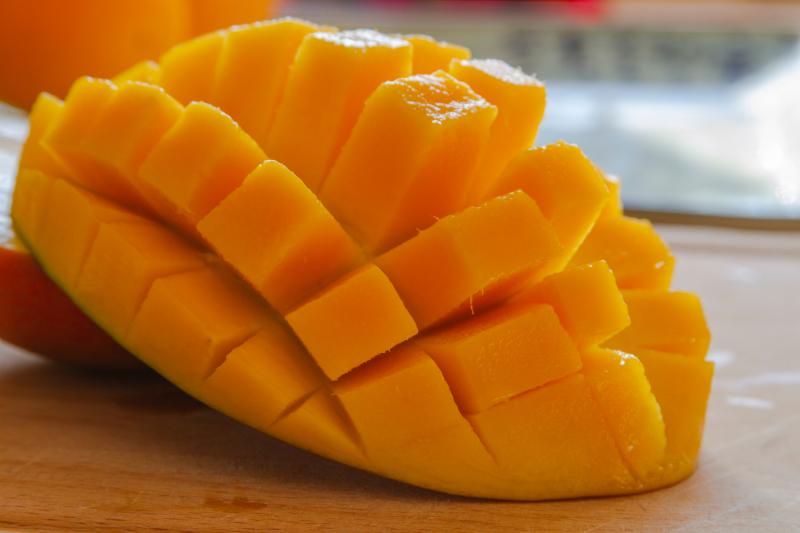
However, the key to enjoying mangoes without discomfort lies in selecting the right variety and ensuring the fruit is fully ripe, as these factors significantly influence the fruit’s acidity levels and overall gentleness on the stomach.
Did you know that there are hundreds of mango varieties worldwide, each with its unique flavor profile and acidity level, offering a myriad of choices for every palate and digestive sensitivity?
Let’s delve deeper into how fully ripe specific varieties can cater to those with dietary restrictions, highlighting the perfect balance between indulgence and health.
Highlights
- The acidity of mangoes changes dramatically as they ripen, starting from a high acidity level of 3.40 to 4.80 in green, unripe mangoes. As they mature, their acidity decreases significantly, allowing fully ripe mangoes to reach a pH level of around 5.80 to 6.00. This shift makes ripe mangoes much less acidic than many other fruits and suitable for those who need to avoid high-acid foods.
- There are so many different kinds of mangoes around the world, each with its own taste and acidity level. It’s good to know that there are specific varieties, like the Alphonso from India and the Ataulfo from Mexico, which are sweeter and have less acid, so they’re better for a sensitive stomach.
- To pick the perfect ripe mango for a low-acid diet look for ones that are slightly soft, have a fruity smell at the stem, and, depending on the variety, a yellow to orange hue. This will help you enjoy mangoes without triggering GERD symptoms, adding a delicious and safe option to your diet.
In this article:
- Are Mangoes Acidic?
- Are Dried Mangoes Acidic?
- Are Frozen Mangoes Acidic?
- Factors Influencing Mango’s Acidity
- Ripeness and its Influence on Acidity Level
- Low-Acidic Varieties
- More Acidic Varieties
- Cultivation Conditions
- Mangoes for Low Acid Diet
- Ripe Mango Indicators
- How to Ripen Mangoes?
- How to Integrate Mangoes in Low-Acid Diet Simply?
Are Mangoes Acidic?
Mangoes exhibit a range of acidity levels, with green, unripe ones having a pH of 3.40 to 4.80, while fully ripe mangoes show a much lower acidity, with pH levels from 5.80 to 6.00 [1].
This means that as mangoes ripen, they move from being quite acidic to almost neutral, making them less acidic than many other fruits, including bananas, which have a pH range of 4.5 to 5.2.
A fully ripe Alphonso mango, for example, can reach a pH close to 6.0, indicating it’s exceptionally mild and even more accommodating for those sensitive to acidic foods.
Thus, ripe, low-acid mango varieties offer a delightful blend of sweetness with minimal acidity, suitable for a wide audience.
Are Dried Mangoes Acidic?
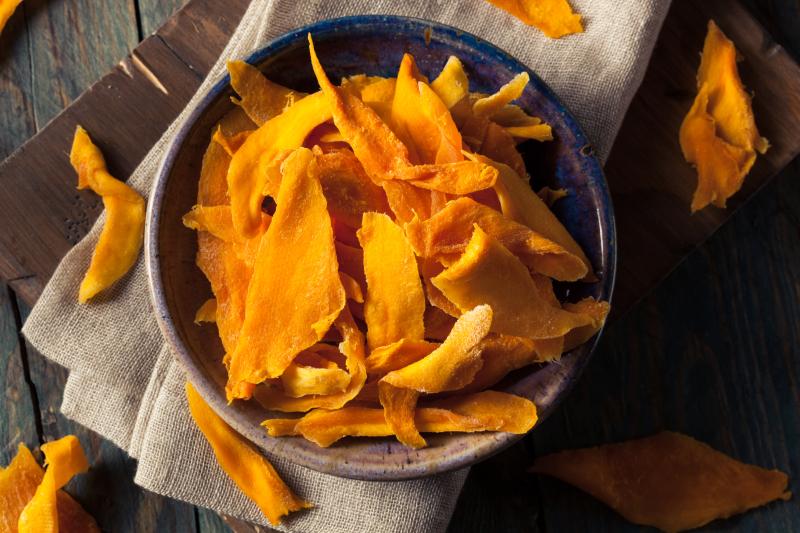
Contrary to popular belief, dried mangoes may seem sweeter and less acidic than their fresh counterparts, a perception often influenced by the addition of sweeteners.
As mangoes are dried, their moisture content diminishes, which naturally concentrates both the sugars and acids, potentially intensifying the tanginess.
However, producers frequently add sweeteners to dried mangoes, not only to enhance their sweetness but also to mask any increased acidity, creating a flavor profile that is pleasantly sweet and seemingly less acidic.
This process, along with factors like the fruit’s original ripeness, country of origin, and variety, significantly shapes the final taste of dried mangoes, making them a favorite for those who prefer a sweeter, less tart snack.
Are Frozen Mangoes Acidic?
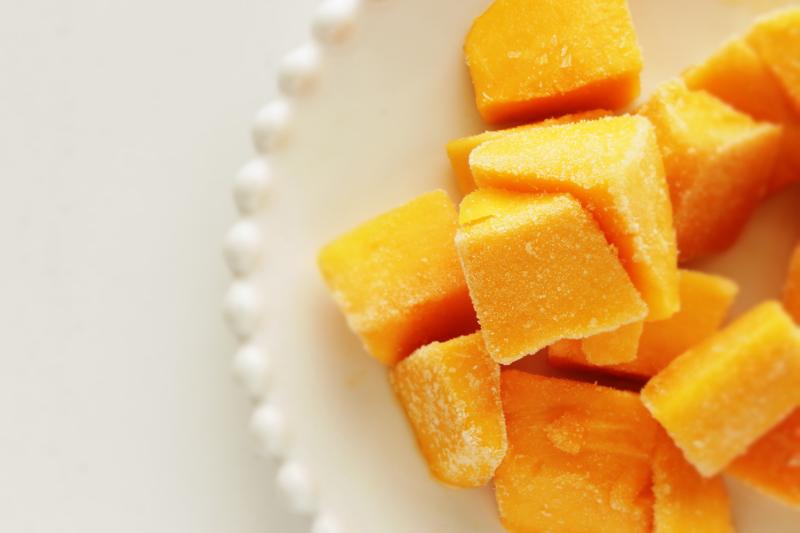
Frozen mangoes generally have a slightly milder acidity compared to fresh mangoes.
When mangoes are frozen, the freezing process can help to mellow out their acidity levels to some extent.
During the freezing process, the cellular breakdown and ice formation can slightly alter the perception of acidity in mangoes.
However, the exact acidity level can still vary depending on factors such as the ripeness of the mangoes before freezing and any processing methods used.
Factors Influencing Mango’s Acidity
Several factors can influence the acidity of a mango, including:
- Ripeness: Unripe mangoes are more acidic. As they ripen, the acidity decreases, and the sweetness intensifies.
- Variety: There are hundreds of mango varieties, each with its unique flavor profile and acidity level.
- Cultivation Conditions: Climate, soil type, and other environmental factors can affect the acidity of mangoes.
Ripeness and its Influence on Acidity Level
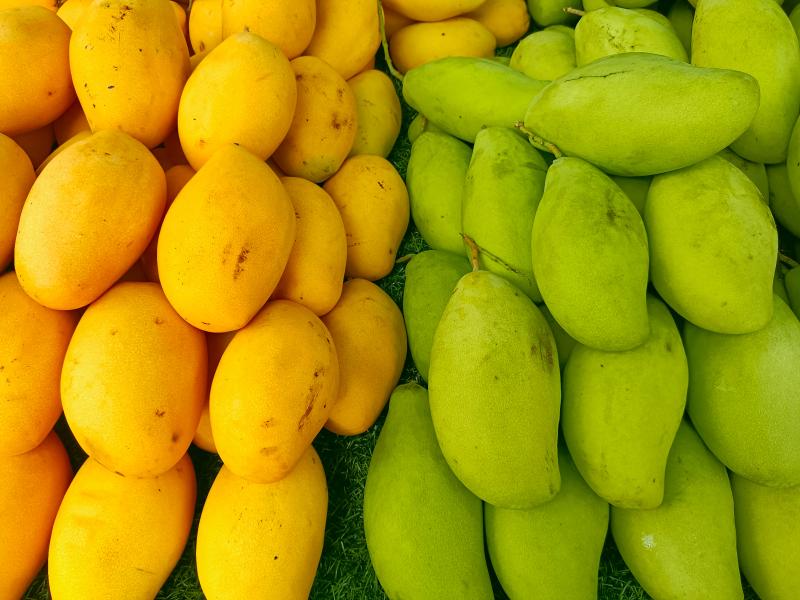
Ever noticed how mangoes transform as they ripen? It’s not just about color and texture; their flavor does a 180 too.
As mangoes ripen the acids that contribute to their initial tartness begin to decrease, and the fruit starts to produce more sugars.
This natural progression from acidic to sweet makes the ripe mango a completely different culinary experience.
The flesh becomes softer, juicier, and the sweetness intensifies, overshadowing the once-dominant acidic taste.
This sweetness is not just a simple sugar rush; it’s a complex, layered flavor that can vary significantly between different varieties of mangoes.
Low-Acidic Varieties
Mango varieties that are renowned for their sweet, low-acidic flavor include:
1. Alphonso (India)
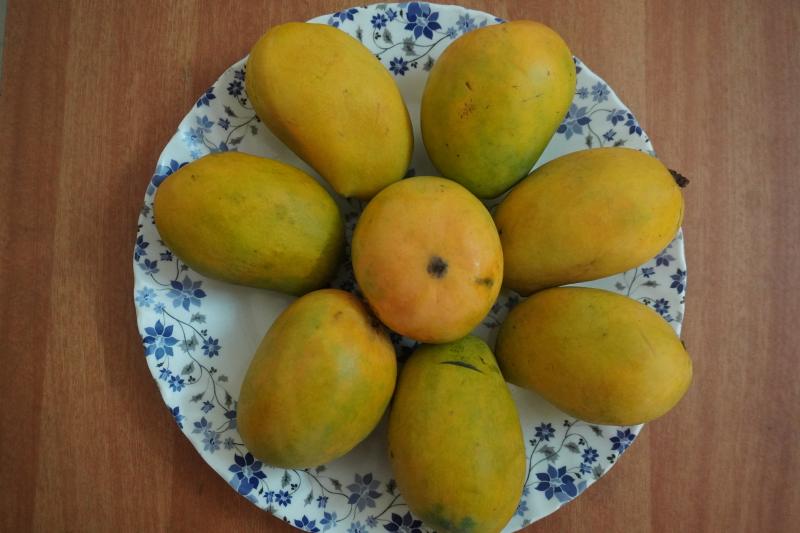
- Flavor: Often hailed as the “King of Mangoes,” Alphonso mangoes are celebrated for their rich, creamy texture and distinctly sweet, low-acidic flavor.
- Color: The skin is golden-yellow and develops a pinkish-red blush on the sun-exposed side.
- Availability in US market: Available in limited quantities in the US market during the late spring and early summer months.
2. Ataulfo (Mexico)
- Flavor: Also known as Honey mangoes, they boast a buttery texture and a sweet, yet slightly tangy taste, placing them among the lower acidity varieties.
- Color: Have a bright yellow skin when fully ripe and are known for their small, oblong shape. The flesh is deep yellow, creamy, and fiberless.
- Availability in US market: From March to July, with peak availability typically in May and June.
3. Nam Dok Mai (Thailand)
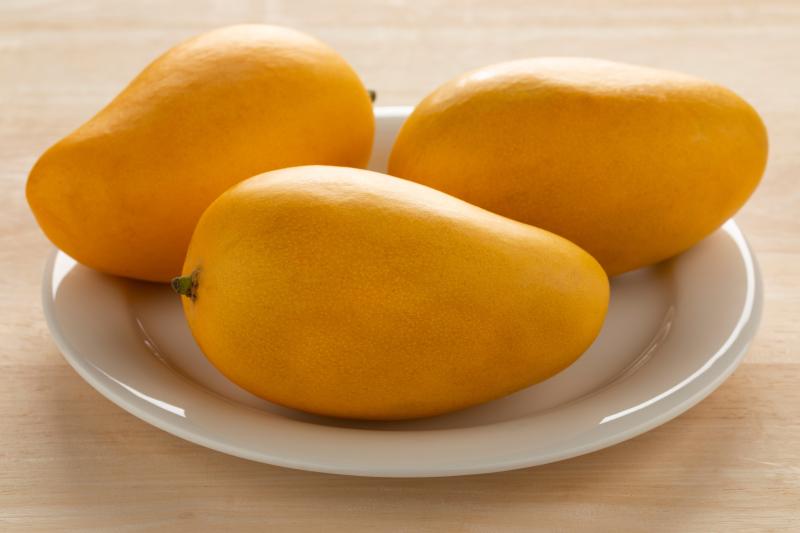
- Flavor: This indigenous variety is renowned for its sweet flavor and smooth texture.
- Color: Typically small to medium-sized, yellow-golden in color when ripe, both in skin and flesh.
- Availability in US market: From March to July, with peak availability typically in May and June.
4. Palmer (Florida)

- Flavor: Prized for their exceptionally sweet and aromatic flavor. They have a smooth, non-fibrous texture and a rich, tropical taste with floral undertones.
- Color & Size: When ripe, Palmers have a dark red to purple skin when.
- Availability in US market: Typically available in the fall.
5. Valencia Pride (Florida)
- Flavor: Valencia Pride mangoes are known for their sweet and tangy flavor with subtle citrus notes. They have a smooth, fiberless texture and a rich, tropical taste.
- Color: Have a long, slender shape with a skin that turns bright yellow with a pinkish-red blush when ripe.
- Availability in US market: Available in the winter months.
More Acidic Varieties
Varieties known for a higher acidity, which adds a vibrant tanginess to their flavor, are:
6. Tommy Atkins (USA, Brazil, Chile)
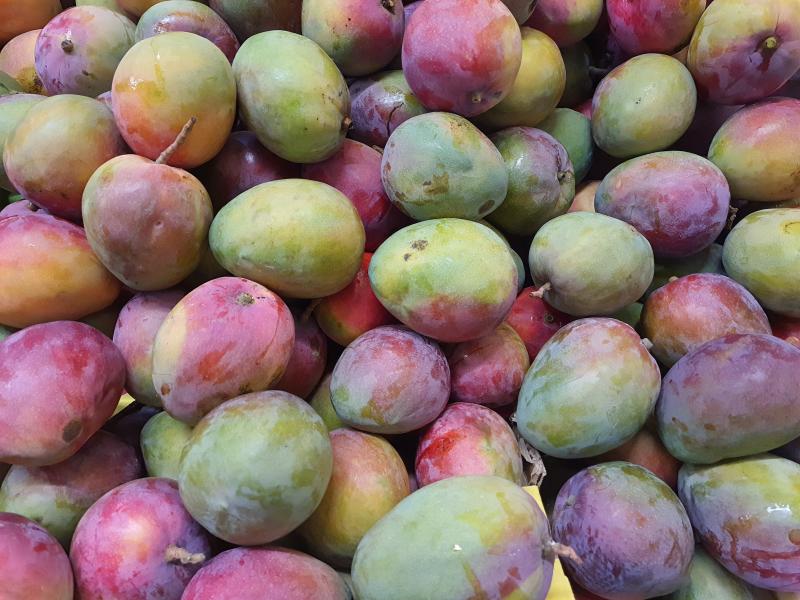
- Flavor: Mildly sweet but come with a firmer, fibrous texture and a higher acidity.
- Color: Tommy Atkins typically have a combination of red, orange, and green hues when ripe.
- Availability in US market: From March to September, with peak availability typically in June and July.
7. Keitt (Florida, Israel, South Africa)
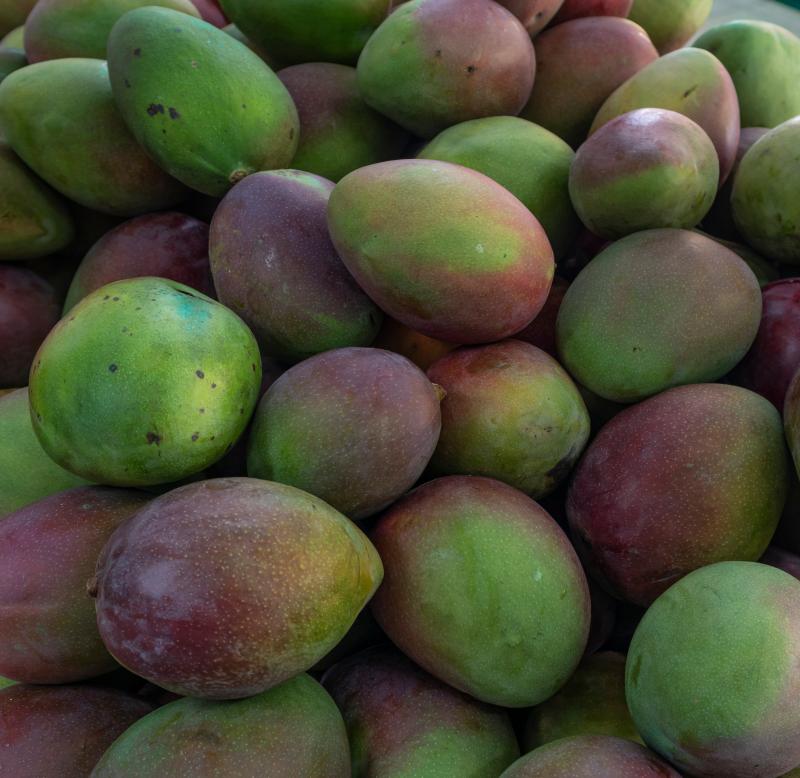
- Flavor: These mangoes have a sweet and mildly tangy flavor with subtle tropical fruit undertones. They are juicy and have a firm, fiberless texture.
- Color: Mostly green even when ripe, with some hints of pink or yellow. The flesh is pale yellow to greenish, sweet, and slightly tangy, with minimal fibers.
- Availability in US market: In the late summer and fall months, with some availability extending into early winter in certain regions.
8. Kent (Mexico, Florida, Peru)

- Flavor: While sweet and rich with a juicy, tender flesh that has minimal fibers, can exhibit a higher acidity level, contributing to their refreshing zest.
- Color: They have a reddish-yellow skin when ripe.
- Availability in US market: From June to September, with peak availability typically in July and August.
9. Haden (Florida, Mexico)
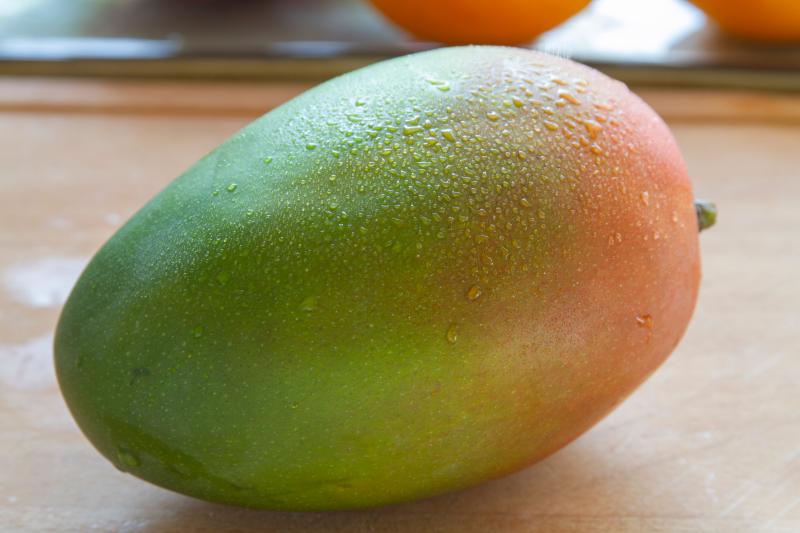
- Flavor: Are known for their rich, sweet flavor with hints of citrus and tropical fruit notes. They have a smooth, buttery texture.
- Color: When ripe, Hadens display a vibrant combination of red, orange, and yellow hues, often with green undertones.
- Availability in US market: Widely available in the spring and early summer months.
Cultivation Conditions
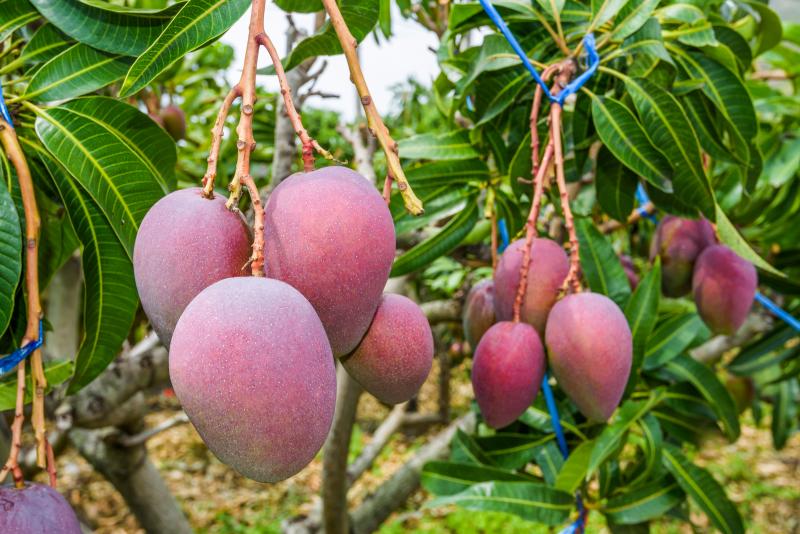
Geographical locations where mangoes are grown and imported from can significantly impact their acidity levels.
For example, mangoes from regions like Mexico, India, Thailand, and even parts of the United States, such as Florida and California, are known for their tropical or subtropical climates and fertile soils, often resulting in sweeter fruit.
Conversely, mangoes grown in regions with cooler climates or less favorable soil conditions, such as certain parts of Europe like Spain or high-altitude areas in South America, may exhibit higher acidity levels and a more tart taste.
Additionally, factors such as altitude and proximity to coastal areas can further influence the flavor profile of mangoes, with fruits from higher elevations or coastal regions often boasting unique acidity levels and flavor nuances.
As a result, consumers may encounter a diverse range of mango flavors depending on the geographic origin of the fruit.
Mangoes for Low Acid Diet
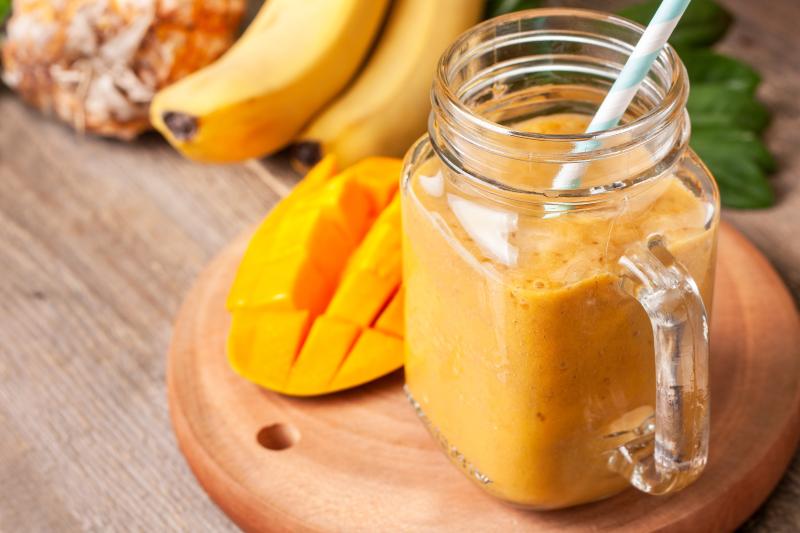
Mangoes, with their milder acidity compared to some other fruits, are often recommended as part of a low-acid diet, particularly for individuals seeking to minimize foods that could exacerbate conditions like acid reflux, GERD, sensitive stomachs or other digestive issues.
As mangoes ripen, they become sweeter and even less acidic to the taste, akin to bananas.
However, it’s essential to note that mangoes initially have a higher acidity level than bananas, usually recommended for low acid diet, and may present a range of sweet and tart flavors, depending on the variety.
To minimize the risk of stomach irritation and manage GERD symptoms effectively, choosing fully ripe, sweeter varieties of mangoes is beneficial.
The natural maturation process reduces the fruit’s natural acids, making them potentially less likely to trigger GERD symptoms and acid reflux.
Ripe Mango Indicators
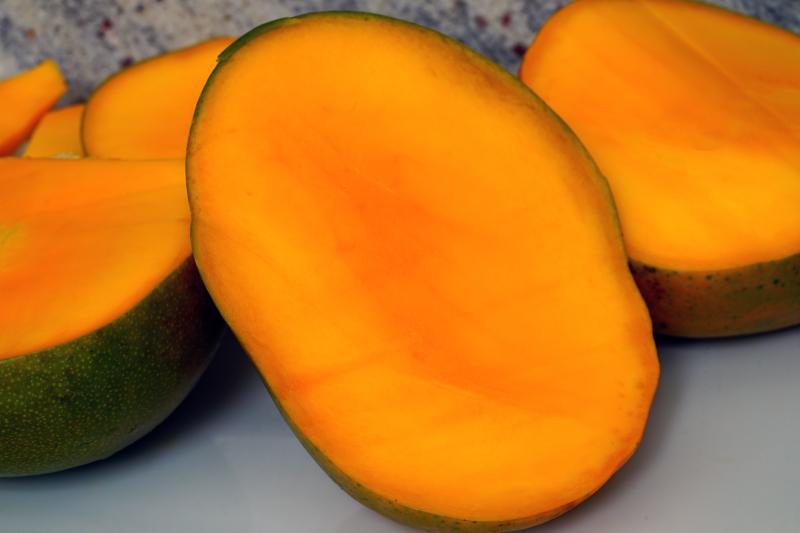
Mangoes continue to ripen after harvest, so consider purchasing mangoes that are still slightly firm if you don’t plan to consume them immediately.
Allow them to ripen at room temperature until they reach your desired level of softness and flavor.
Color: While color can vary significantly across different mango varieties, a ripe mango often has a yellow or orange hue, possibly mixed with other colors depending on the variety. However, some ripe mangoes can also remain green, so color alone is not always the best indicator.
Firmness: Gently squeeze the mango. If it’s hard, it’s not ripe yet. Ripe mangoes yield slightly to pressure but should still feel firm, similar to an avocado. Avoid mangoes that are too soft or mushy, as they may be overripe or spoiled.
Aroma: Smell the stem end of the mango. A ripe mango will release a sweet, fragrant aroma from its stem. If it smells sweet and fruity, it’s likely ripe and ready to eat.
Texture: The skin of a ripe mango should feel smooth and slightly waxy. Avoid mangoes with wrinkled or shriveled skin, or with large bruises as this may indicate dehydration or spoilage.
Variety-Specific Indicators: Each mango variety may have unique ripening characteristics. Familiarize yourself with the specific traits of the variety you prefer. For example, some varieties develop blushes or patches of color as they ripen, while others remain predominantly green even when ripe.
By following these guidelines and considering the specific characteristics of different mango varieties, you can select ripe mangoes that are ideal for your preferences and intended use.
How to Ripen Mangoes?
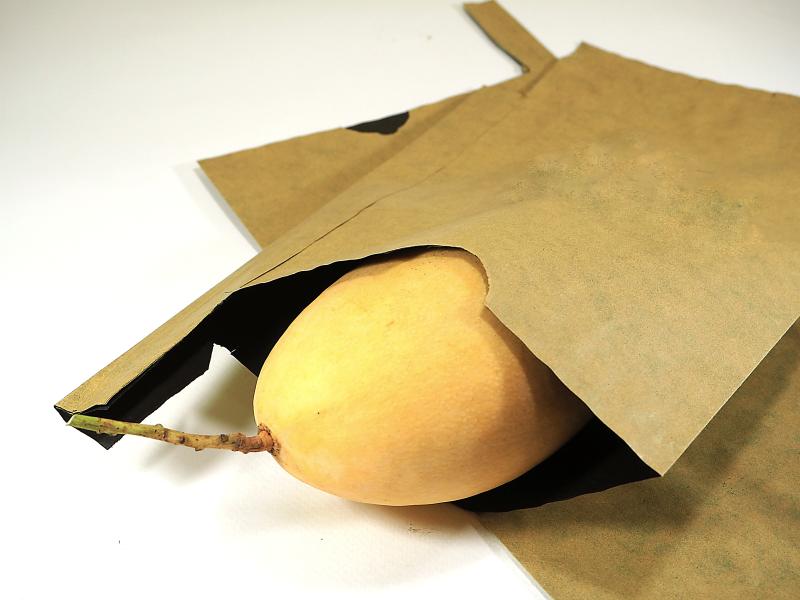
How many times have disappointing grocery trips left you with bland, overly acidic mangoes?
Exercise patience and ripen them at home for a flavorful and enjoyable experience — just avoid common mistakes in ripening mangoes:
- Avoid placing them under direct sunlight.
- Refrigerate only when fully ripe to preserve flavor and texture.
- Ripen them in a paper bag at room temperature (68°F to 77°F or 20°C to 25°C).
- Add other fruits like bananas or apples, which release ethylene gas to accelerate ripening process.
- Check daily for ripeness by gently pressing the mango.
- Once it gives slightly and emits a sweet aroma, it’s ready to enjoy.
How to Integrate Mangoes in Low-Acid Diet Simply?

When incorporating mangoes into the diet for GERD or acid reflux, it’s crucial to pay attention to portion sizes, avoid trigger foods, and listen to your body’s response.
By choosing ripe mangoes of a low-acid variety and incorporating them into these GERD-friendly recipes, individuals with acid reflux can enjoy the sweet and tropical flavor of mangoes without exacerbating their symptoms.
- Plain Ripe Mango: Enjoying a small serving of ripe mango on its own can be a safe option for many people with GERD or acid reflux, as long as they tolerate it well. It’s essential to pay attention to individual triggers and portion sizes.
- Mango Infused Water: Add slices of ripe mango to a pitcher of water for a refreshing and subtly flavored drink. This can be a gentle way to enjoy the taste of mango without consuming concentrated amounts of fruit.
- Mango Smoothie: Blend ripe mango with a small amount of almond milk or coconut water for a basic smoothie. Avoid adding acidic or citrus fruits, dairy, or large quantities of sweeteners, as these can potentially trigger reflux symptoms.
- Mango Yogurt: Mix diced ripe mango with plain, non-fat Greek yogurt for a creamy and satisfying snack. Opt for yogurt without added sugars or flavors to minimize the risk of exacerbating symptoms.
- Mango Sorbet: Make a simple mango sorbet by blending frozen mango chunks with a small amount of water or coconut milk. Avoid adding citrus juices or excessive sweeteners.
If unsure about specific foods, it’s best to consult a healthcare provider or registered dietitian for personalized dietary guidance.
Final Words
The journey through the world of mangoes reveals a fascinating interplay between acidity and sweetness, intricately linked to the fruit’s ripeness and geographical roots.
As mangoes ripen, they undergo a remarkable transformation, shedding their acidic bite for a richer, more profound sweetness.
This is further impacted by their country of origin.
Varieties such as the Alphonso mangoes from India, renowned for their exceptional sweetness and lower acidity, and the Ataulfo variety, known for their rich, sweet flavor with minimal fibrous texture and low acidity, are particularly sought after.
On the other hand, Tommy Atkins mangoes, prevalent in the USA and Brazil, are known for their balanced mix of sweetness and a more noticeable acidic kick.
For individuals dealing with GERD or acid reflux, understanding these differences is crucial.